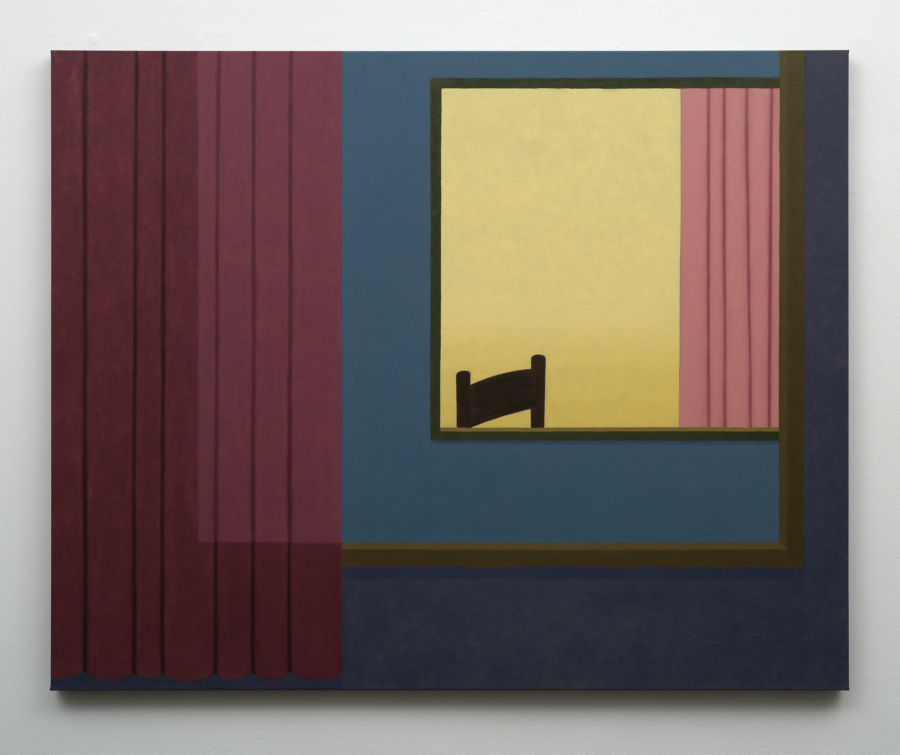Paul Mogensen, published by Karma, New York, 2018.
Download as PDF
Paul Mogensen is available here
In the practice of science and mathematics, one speaks of an “elegant” solution when it is gracefully concise and simple. Paul Mogensen has meshed this definition of elegant with the practice of art. For almost thirty years now he has combined the basic givens of mathematics, unmixed color, and the materiality of his painting support in a growing panoply of simple, succinct solutions that yield complex and intense visual rewards. His paintings evolve directly out of the rules of their making; form, color, and configuration define and generate each other.
Mogensen, like many of his peers who came to the fore in the 1960s and were given the limiting sobriquet “minimalist,” set out to make the implicit planar architectonics of painting physically explicit and self-evident. He had long been attracted to the thorny abstraction of Clyfford Still and set about seeking solutions just as self-revelaory and relentless in their reductivism—solutions that would not be, as are Still’s, subjective, spiritualized reifications of painting’s procedures, but rather completely objective ones. Mogensen’s sharp geometries and terse surfaces are at a far remove from Still’s craggy shapes and textures, but they share with Still’s a kind of ruthless beauty at once obvious, implacable, and confoundingly rich.
Within the seemingly rigid confines of the rules of making Mogensen employs—the exclusion of intuitive invention in favor of mathematically generated forms, the rejection of mixed color, and the suppression of personal touch—he has achieved a remarkable variety of conclusions. In his case, the elimination of invention has made discovery not only possible but accessible. For many years, Mogensen did not date or title most of his works, thereby drawing attention not to the personal development of the artist but to the simultaneous immediacy and timelessness of his paintings’ constructs. The three paintings exhibited here all partake of the same ineluctable rigor but span twenty-seven years and are very different in configuration and appearance.
Copperopolis (1966) is generated by a geometric progression originating with the small square at the lower right corner and progressing vertically and horizontally, with the space between the units equal to the height (in the vertical) or width (in the horizontal) of the previous unit. The progression continues until it closes in a square at the upper left corner and is bounded by an overall square measuring 11 feet by 11 feet. It includes a central diagonal of squares. This frugal geometry is obvious yet resonates with a fugal complexity. The fact that the units are not closed in a discrete form creates a continuous play with the interlocking crosses of the intervening negative spaces of the wall. This brings about continuous visual shifts that are at once created by and undermine the fixed mathematical logic of the progression. The act of seeing and the abstract, mathematical calculations of reason are joined in dynamic polyphony. The viewer is drawn into a constant recreation of the work; the real space of wall and flat painting plane becomes as illusive as it is implacably physical. Reason becomes a visual conundrum.
This polyphonic structuring is made even more complex in Stealth (1987), on a single canvas plane, glossy rectangular bands are painted on a matte ground of the same color (the glossiness results from it being an added layer of paint). Sets of simple harmonic progressions of sequences of small whole numbers dictate not only the interior configuration but also the relation of the width of the canvas plane to its height. Out of a radical, self-contained reduction of form, color, and surface, a flickering musicality ensues, calling to Renaissance theories of architecture and actual musical composition.
In Black Widow (1993), the interdependent play of positive and negative, circularity, spirality, and squareness once again turns the self-evident into an unexpected spin of visuality. The two diagonal rows of cutout circles meet in the center of the square canvas, not in a negative but in a positive circle that contains a spiral. The band of the spiral becomes progressively longer as it turns outward from the center and changes color at every quarter turn, progressing in the order of the colors of the spectrum. Color, the most irrational and emotional of the painter’s tools and the one most frequently denied in minimalist practice is here arrayed in polychrome—but in a polychrome derived from the objectively known. Four other circles with interior spirals take their place in the remaining space of the canvas. The square becomes a set of circular revolutions that are hallucinations of the objectively verifiable.
Mogensen’s paintings find their forebears in Malevich and Mondrian and Delaunay; he has utterly objectified the intuited relation of their geometric configurations and made his processes fully and simply knowable. He has achieved this without sacrificing any of the visual ambiguity and resonance with which the best of painting challenges and reflects the working of our consciousness.
Published on the occasion of
Paul Mogensen
September 27–November 4, 2018
Karma
188 East 2nd Street
New York, NY 10009
Published by
Karma Books, New York
Edition of 1,000
Special edition of 50



